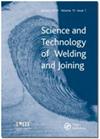焊缝根尖对钛合金厚板电子束焊接接头组织和力学性能的影响机理
IF 3.7
3区 材料科学
Q2 MATERIALS SCIENCE, MULTIDISCIPLINARY
Science and Technology of Welding and Joining
Pub Date : 2023-10-05
DOI:10.1080/13621718.2023.2262794
引用次数: 0
摘要
摘要钛合金厚板焊接时,由于熔合不充分,常在焊缝根部形成狭窄的焊缝,称为“焊缝根尖”,从而降低接头性能。本研究采用电子束焊接方法对30mm厚Ti-5Al-5Mo-5V-1Cr-1Fe合金进行对接焊接,揭示焊缝根尖对接头组织和力学性能的影响机理。熔合区中心线与边缘焊缝角为0°-3°的亚平行或平行焊缝去除了焊缝根尖,可获得与焊接区几乎相同的力学性能。关键词:钛合金选择电子束焊接焊接根尖机械性能数据可用性声明再现这些发现所需的原始/处理数据目前不能共享,因为这些数据也是正在进行的研究的一部分。披露声明作者未报告潜在的利益冲突。本研究由中国科学院青年创新促进会(2021193、Y2021061)和辽宁省振兴人才计划资助,资助号:XLYC2002099。本文章由计算机程序翻译,如有差异,请以英文原文为准。
Influencing mechanisms of weld root tip on microstructure and mechanical properties of electron beam welded joints of titanium alloy thick plates
AbstractThe welding of titanium alloy thick plates often formed a narrow weld seam in the weld root, named as ‘weld root tip’, because of insufficient fusion, which could reduce the joint properties. In this study, 30 mm-thick Ti-5Al-5Mo-5V-1Cr-1Fe alloy was butt welded via electron beam welding to reveal the influencing mechanisms of the weld root tip on joint microstructure and mechanical properties. The subparallel or parallel weld seam with the weld angles of 0°–3° between the centre line and edge of the fusion zone removed the weld root tip, achieving almost the same mechanical properties with those of the welding zone.KEYWORDS: Titanium alloysElectron beam weldingWeld root tipMechanical properties Data availability statementThe raw/processed data required to reproduce these findings cannot be shared at this time as the data also forms part of an ongoing study.Disclosure statementNo potential conflict of interest was reported by the author(s).Additional informationFundingThis work was supported by the Youth Innovation Promotion Association Chinese Academy of Sciences (2021193 and Y2021061) and Liaoning Revitalization Talents Program under grant number XLYC2002099.
求助全文
通过发布文献求助,成功后即可免费获取论文全文。
去求助
来源期刊

Science and Technology of Welding and Joining
工程技术-材料科学:综合
CiteScore
6.10
自引率
12.10%
发文量
79
审稿时长
1.7 months
期刊介绍:
Science and Technology of Welding and Joining is an international peer-reviewed journal covering both the basic science and applied technology of welding and joining.
Its comprehensive scope encompasses all welding and joining techniques (brazing, soldering, mechanical joining, etc.) and aspects such as characterisation of heat sources, mathematical modelling of transport phenomena, weld pool solidification, phase transformations in weldments, microstructure-property relationships, welding processes, weld sensing, control and automation, neural network applications, and joining of advanced materials, including plastics and composites.
 求助内容:
求助内容: 应助结果提醒方式:
应助结果提醒方式:


